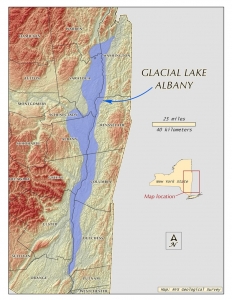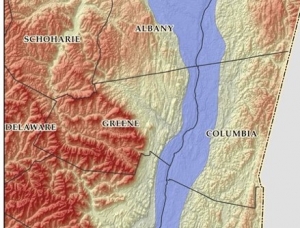Glacial Lake Albany
The Greenville Press; Mar. 20, 2003
Updated by Robert and Johanna Titus
The upper Hudson Valley is a very picturesque region. Most of us take at least a little time to wander around and just plain enjoy the scenery. That includes us but, as geologists, we have the privilege of seeing the world around us in more than just one way. Just like you we see the scenery all around as it is today and, as we said, that is very nice around here. But there are two other landscapes that we are very fond of enjoying. One of those is the landscape preserved in the rocks. Whenever we see an exposure of the local bedrock, it takes us back to a Greene County of long ago. And we mean very long ago; we are witness to the landscapes and seascapes of hundreds of millions of years ago. These rocks are time machines that really can transport us, in our mind’s eye, to those distant eons. Then there is still another vision of the past, that’s the one preserved in today’s landscapes. We geologists call the science of landscape geomorphology and when we study our landscapes, we see the scars of the past. When you learn to read landscape, you learn to read history. It’s a history just a little less ancient than that preserved in the rocks, but just as fascinating.
Here in Greene County, if you know what to look for, there is a fine record of a wondrous geological event of the recent past. That event is one of the most remarkable discoveries in the history of geology: The Ice Age. A mere 20,000 years ago the whole Hudson Valley, including Greene County, was in the grips of a great glaciation. Thousands of feet of glacial ice lay upon our landscape, and that certainly includes right where you are today. The best evidence for that event is in the lay of the land, and you might be surprised to learn that it is in the most inconspicuous part of the landscape. A great deal of eastern Greene County is made up of very flat land. That’s the swath of land lying within five miles of the Hudson River. That’s pretty much everything east of the New York Thruway, much of it is traversed by Rte. 9. we are not talking about a flatness to rival Iowa, but we are talking about a reasonably widespread flat landscape. Pay attention as you drive around just east of the Hudson and see if you notice this yourself.
A level landscape may seem monotonous, but we have to be careful here. What does all that monotony represent? The answer is that this is the floor of an old lake. It was a very big lake and it dates back to the end of the Ice Age. Wherever you are, we would like you to go outside and look north. In your mind’s eye we would like you to see a great glacier in that direction. It towers hundreds of feet above the horizon and stretches off to the east and west. It dominates the landscape, but this is the end of the Ice Age and it is melting. Great volumes of meltwater are cascading off of it.


Glaciers are heavy, so heavy that they actually press down on the land and cause the crust to sag beneath them. Back then our Greene County had been glacially depressed by about several hundred feet. That created a basin and that basin was kept filled with the very cold waters flowing out of the melting ice. That’s our lake. It’s called Glacial Lake Albany and back its waters stretched south most of the way down the Hudson Valley.
Lakes accumulate sediments, mostly clay, silt and sand, and our lake was no exception. In fact, our lake accumulated very thick sequences of sediment at a very rapid rate. The sediments here are at least scores of feet thick and probably even more than that. Lake sediments are spread out by lake currents and that makes for flat lake bottoms. When the waters drain away, those old lake bottoms are left, high and dry, as flat landscapes and that is what you will see throughout eastern Greene County.
How deep was the lake? Geologists can’t help but ask that question. We found that the bottom of the lake in Leeds was at an elevation that is today 150 feet. The shoreline of the lake can be determined where the flat lake bottoms disappear. The shorelines appear to be at about 220 feet and therefore the lake must have been about 70 feet deep. That’s a preliminary figure; we have a lot more research to do here, but that’s a lot of lake.
There were islands in this lake as well. They are hills now, rising above the flat old lake bottoms. The western side of the city of Catskill is an old island. So too is Flint Hill, a site famous as the site of an Indian flint making industry. You should try to get used to this as you travel around eastern Greene County. You will soon become comfortable with the flat old lake bottoms and, after that, you should soon find it easy to “see” the old islands. It makes a difference in how you see this region.
Lake Albany did not last all that long, perhaps only for centuries; we are not sure. With time the glaciers melted away to the north. With their weight removed the landscape rebounded; it physically rose upwards a couple of hundred feet. With that, the waters of Lake Albany were unceremoniously dumped down the Hudson and into the sea. Eastern Greene County returned to its normal condition as a dry landscape. But it had been changed, as the old lake bottoms were left, mostly undisturbed. In the thousands of years that have passed by since then, local rivers have carved their valleys into the old lake bottom and a lot of that flatness has been lost, but much or most of the lake bottom is still here to be seen.
Again, we would like you to notice this. Please do watch for those long flat stretches of landscape as you drive around. We like the stretch of Rte. 9 for the five miles south of Coxsackie. You will notice a lot of flat land here. Pick a good place and then stop, get out of your car, look up, and return to the past. High above, you can see the Sun’s rays shining through the surface waters of the lake. As waves pass by above you, the sunlight sparkles in the choppy waters. Here and there, you can observe the undersides of small drifting cakes of ice, tiny icebergs, searching vainly for tiny Titanic’s. Now look around you and see the ancient lake bottom as it was. The muds lie silently at the bottom of the lake. There are few currents this far down. It is mostly very cold and very dark down here. Our journey to the bottom this glacial lake is merely a fleeting journey of the imagination, but it should give you a very different impression of eastern Greene County, and take you, perhaps for the first time, into the geological past.
Contact the authors at randjtitus@prodigy.net. Join their facebook page The Catskill Geologist.”





